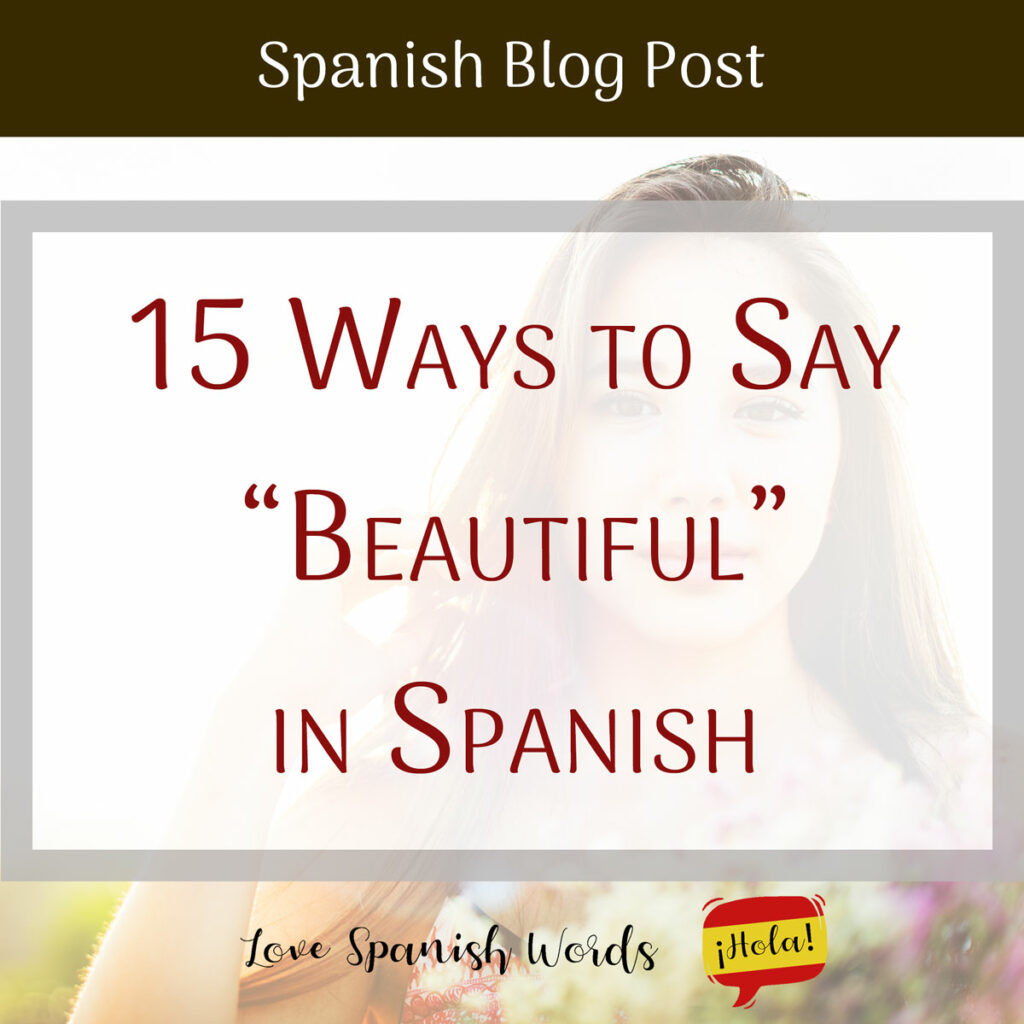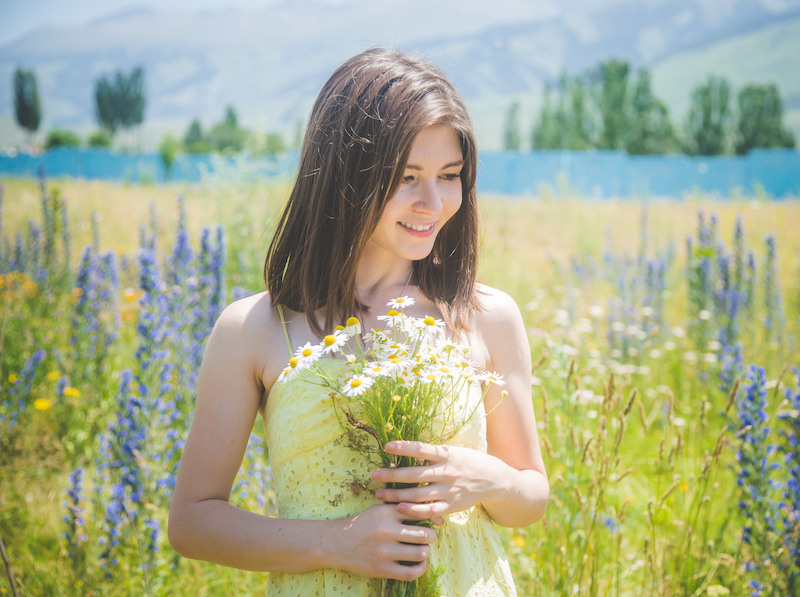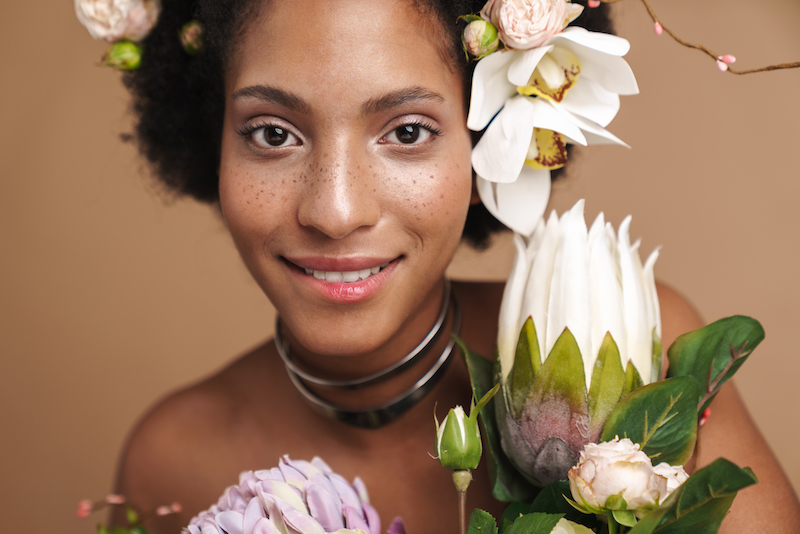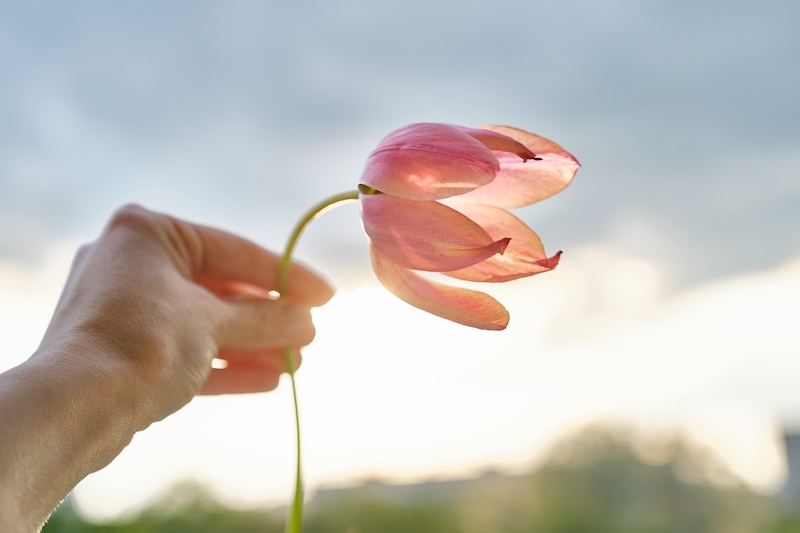There are several ways to say beautiful in Spanish that can enrich your vocabulary and add elegance to your speech. Understanding different expressions for describing beauty and admiration will enable you to communicate more clearly and with greater emotional depth. Today, you will learn various expressions conveying beauty in formal and informal contexts.
Expressions of beauty can vary not only by context but also by the Spanish-speaking country. Moreover, beauty extends beyond physical appearance to encompass a person’s inner beauty.
One popular English phrase is Beauty is in the eye of the beholder. In Spanish, we say, La belleza está en los ojos del que mira. As you may know, Spanish is a very expressive language, and therefore, Spanish speakers perceive beauty everywhere and express it in various ways through words or actions. Let’s explore the many different ways to express beautiful in Spanish.

Formal Ways to Say Beautiful
First, let’s look at the more formal ways to talk about beauty in Spanish. These expressions allow you to show your admiration for a sunset, a lovely view, someone’s physical appearance, or their stylish outfit. While they are suited for formal settings, they can also be used informally to convey a deep appreciation for beauty.
Hermoso / Hermosa
Hermoso/a is one of the most popular ways to say beautiful in Spanish. It’s used for people, places, or stunning things. This word conveys deep admiration and is perfect for describing something that takes your breath away, whether it’s a person, a view, or an object. Hermoso/a goes beyond simple prettiness; it describes something breathtakingly beautiful.
The phrase de gran hermosura means “of great beauty.” It speaks to the impressive and charming beauty of something, such as a sunset, a building, a decorated event, a lovely dress, or an incredible view.
- La niña tiene una voz hermosa cuando canta. = The girl has a beautiful voice when she sings.
- El vestido de novia es hermoso con encajes y detalles elegantes. = The wedding dress is beautiful with lace and elegant details.
¡Este atardecer es el más hermoso que he visto en mi vida!
This sunset is the most beautiful I have ever seen in my life!
Bonito / Bonita
Bonito/a is another way to say beautiful, but it’s more casual and used for everyday conversation. It means nice, pretty, and lovely, and is often used when something looks good and is pleasing to the eye. You can use it to express yourself about someone or something attractive and visually appealing, as well as when talking about a nice action someone does.
- Qué bonito día hace hoy para jugar afuera. = What a lovely day it is today to play outside!
- ¡Mira qué bonito es este dibujo que hizo! =Look how beautiful this drawing he made is!
Mi mamá me compró un vestido bonito para la fiesta.
My mom bought me a pretty dress for the party.
Precioso / Preciosa
Precioso/a is used to describe beauty in a gentle and lovely way. It’s perfect for describing beautiful things such as art, jewellery, and stories. When using this word, you express your appreciation for refined beauty and delicate, charming, and exquisite things. You can use it to describe someone you find cute, such as a baby or a person who looks pleasing to the eye.
- ¡Mira qué precioso es este mural! = Look how beautiful this mural is!
- ¡Qué precioso arco iris! = What a beautiful rainbow!
El bebé tiene una sonrisa preciosa.
The baby has a beautiful smile.

Deslumbrante
Deslumbrante translates to the English word dazzling and conveys more than just beauty. This word carries depth and expresses how something captured your attention with its shine and brilliance.
It’s the perfect word for describing something impressive that takes your breath away, such as a breathtaking necklace, a beautiful landscape, a piece of artwork, or anything with stunning beauty. Additionally, you can use it to describe a person who has inner beauty and whose personality shines.
- ¡El cielo estrellado estaba deslumbrante! = The starry sky was dazzling!
- La princesa llevaba una corona deslumbrante en el baile. = The princess wore a dazzling crown at the ball.
- Todos los profesores adoran a Ana por su personalidad deslumbrante. = All the teachers like Ana for her dazzling personality.

Gender Neutral Adjectives:
In Spanish, adjectives ending with -a and -o typically change their endings to match the gender (masculine or feminine) and number (singular or plural) of the nouns they describe.
Adjectives ending in –e, such as deslumbrante and radiante, are somewhat less common but they do exist. However, they act differently because these adjectives ending in -e typically remain the same in both masculine and feminine singular forms. Example: la mujer radiante (the radiant woman) or el hombre radiante (the radiant woman)
For plural forms, these adjectives behave like regular adjectives. You keep the -e and add an -s to make it plural. For example, deslembrantes and radiantes.
Fascinante
Fascinante translates to fascinating in English. This adjective describes both outer physical beauty and inner charm that captivates and holds your attention. Derived from the Spanish verb fascinar, which means to fascinate, fascinante is used to talk about something or someone that deeply intrigues or attracts you. Whether you’re referring to a mesmerising piece of art or an enchanting individual, this word captures the essence of being irresistibly captivating.
- El museo tiene algunas obras de arte fascinantes. = The museum has some fascinating pieces of art.
- La mariposa con sus alas de colores brillantes es fascinante. = The butterfly with its brightly colored wings is fascinating.
Elegante
Elegante is a term used to convey feelings towards something that is refined and sophisticated. It describes beauty that is tasteful and graceful, whether it’s a person dressed exquisitely for a formal event like a wedding or a beautifully decorated space such as a grand ballroom or an upscale home.
This adjective captures a sense of stylishness and class. A popular phrase using this word is de elegancia sin igual, which means unparalleled elegance, highlighting the exceptional quality of elegance being described.
- Mamá se veía muy elegante con su vestido para la fiesta. = Mom looked very elegant in her dress for the party.
- La casa de mi abuela es muy elegante y sofisticada. = My grandmother’s house is very elegant and sophisticated.
La bailarina llevaba un vestido elegante durante su presentación.
The dancer wore an elegant dress during her performance.

Encantador / Encantadora
The adjective encantador/a translates to charming in English. It is commonly used to describe inner beauty, particularly someone with a captivating and delightful personality. Beyond people, encantador/a can also describe things that are adorable, lovely, or evoke a sense of magic and beauty, such as enchanting stories or a cute dog.
- El cachorrito era tan pequeño y encantador que todos querían jugar con él. = The puppy was so small and charming that everyone wanted to play with him.
- La abuela contaba cuentos encantadores acerca de princesas. = Grandma told lovely bedtime stories about princesses.
Juan es el hombre más encantador que e conocido.
Juan is the most charming man I have ever met.
Agraciado / Agraciada
The term agraciado/a is another way to describe beauty, though it is less commonly used compared to the other words mentioned. It is often used to describe someone with grace, elegance, or natural beauty. Additionally, agraciado/a can refer to something that is done so gracefully that it appears beautiful.
- El cisne nadaba agraciadamente en el lago. = The swan swam gracefully in the lake.
- La bailarina dio un giro agraciado en el aire. = The dancer did a graceful spin in the air.
Radiante
The descriptive word radiante is used when talking about something bright, shiny, luminous, or full of light. It means radiant in English and it’s used to describe the outward or inner beauty of a person, object, or view.
- El sol radiante brillaba en el cielo.= The radiant sun was shining in the sky.
- El radiante arco iris apareció después de la lluvia. = The radiant rainbow appeared after the rain.
La niña tiene una sonrisa radiante.
The girl has a radiant smile.

Informal Ways to Say Beautiful
There are also many informal phrases to use when talking about beauty. The words below are perfect for chatting with friends or in everyday conversations. Using these phrases to describe something beautiful can make your Spanish sound more personal, friendly, and fun when complimenting someone.
Atractivo / Atractiva
Atractivo/a translates to attractive in English. It’s commonly used in Spanish to describe physical beauty. You can use it to compliment someone on their great appearance, emphasizing their appeal and charm. This word shares a similar tone to elegante, as it describes someone looking good based on how they are dressed. Besides people, atractivo/a can also describe things that are visually pleasing, interesting, or attention-grabbing.
- Los colores vivos hacen que el parque de diversiones sea más atractivo. = The bright colours make the amusement park more attractive.
- La flor rosa en el jardín es muy atractiva. = The pink flower in the garden is very attractive.
El traje que llevaba José lo hacía lucir más atractivo.
The suit that Jose wore made him look extra attractive.
Bello / Bella
The word bello/a is an adjective that describes both external physical beauty and inner grace. It’s typically used informally with friends and family; you wouldn’t necessarily use it with a boss or a stranger. This word can describe someone’s appearance or character as beautiful or express that something is beautiful, such as a stunning sunset or an amazing drawing.
Bello/a is related to the noun belleza, which means beauty. You can use phrases like tiene una belleza cautivadora (he/she/it has captivating beauty) or tiene una belleza extraordinaria (he/she/it has extraordinary beauty) to describe someone or something.
- El parque principal de la ciudad es un lugar bello para hacer un picnic. = The city’s main park is a beautiful place for a picnic.
- El atardecer era tan bello que parecía una pintura. = The sunset was so beautiful that it looked like a painting.
Guapo / Guapa
Guapo/a is a popular way to casually say someone looks good, focusing on the idea of someone being handsome or beautiful. You can say ¡Qué guapo/a eres! which means How handsome/beautiful you are!
Use this word when someone is dressed up nicely for a special event or when they look their best. To emphasise how handsome or beautiful someone looks, you can say ¡Te ves guapísima! which means, You look so gorgeous. Guapo/a is an informal term, so it’s best used with someone close to you, such as friends and family.

Fun Fact:
In the Dominican Republic, although guapo/a is occasionally used to express that someone looks good, it is mainly used to describe someone as being mad or angry.
- El novio se veía muy guapo con su traje de boda. = The groom looked very handsome in his wedding suit.
- Mi tía se veía muy guapa maquillada y peinada. = My aunt looked very pretty with makeup and hair.
Tengo que lucir guapa para mi graduación mañana.
I have to look pretty for my graduation tomorrow.

Chulo / Chula
The adjective chulo/a is another informal way to say something or someone looks nice. It’s best to use this word only with friends and family because one possible translation is pimp. However, it can also describe someone who looks cute or cool. You might use chulo/a to talk about an object that’s cute or something that will make someone look stylish, such as cool shoes or a cute dress.
- ¡Qué chulo ese vestido! = That dress is beautiful/cute!
- Te ves chula, mi amor. = You look great/cool, my love.
¡Mi hija es la más chula de todas!
My daughter is the cutest of them all!
Lindo/Linda
Lindo/a is an informal word used to describe someone as lovely or pretty. It’s commonly used in casual conversation to praise someone’s looks. Beyond describing a person’s physical appearance, lindo/a can also refer to someone’s inner beauty or their lovely actions.
Additionally, lindo/a is often used to express that an object or scene is lovely. For instance, you might use it to describe a kitten, a beautiful mountain view, a pair of shoes, or a beautifully decorated party.
- ¡Eres muy linda! = You are very pretty!
- ¡Tu mamá decoró el pastel muy lindo! = Your mom decorated the cake so beautifully!
- El cachorro es tan lindo con sus orejas. = The puppy is so cute with its long ears.
El anillo que me regaló mi prometido es extremadamente lindo.
The ring my fiancé gave me is extremely beautiful.
Majo / Maja
The word majo/a is a colloquial adjective used to describe someone in various nuances and contexts. It means nice, pleasant, friendly, or attractive. When used to describe someone as beautiful, it implies they look attractive in a charming way.
Additionally, majo/a can be used to describe objects, such as a piece of clothing, a flower, or someone’s eyes, highlighting their appealing or pleasant nature.
- El actor lució un traje muy majo en la gala.= The actor wore a very nice suit at the gala.
- La flor en el jardín era tan maja que todos querían tomarle fotos. = The flower in the garden was so lovely that everyone wanted to take pictures of it.
- El bebé tiene unos ojos majos que me derriten el corazón. = The baby has beautiful eyes that melt my heart.

